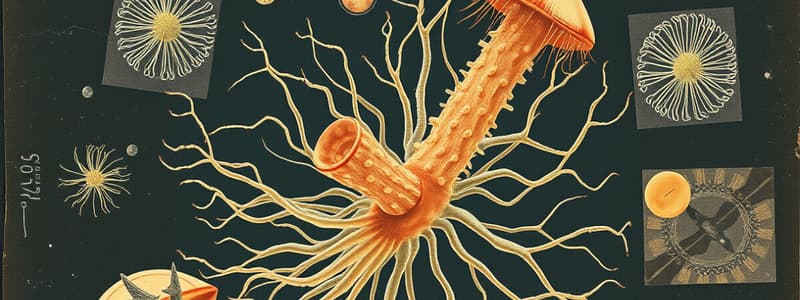Podcast
Questions and Answers
Do cnidarians have symmetry?
Do cnidarians have symmetry?
True (A)
What type of symmetry do cnidarians have?
What type of symmetry do cnidarians have?
radial symmetry
What are cnidarians made of?
What are cnidarians made of?
cells and tissues
What type of feeders are cnidarians?
What type of feeders are cnidarians?
What do cnidarians have for food?
What do cnidarians have for food?
What type of body plans do cnidarians have?
What type of body plans do cnidarians have?
Describe the polyp body plan.
Describe the polyp body plan.
Describe the medusa body plan.
Describe the medusa body plan.
What do cnidarians have to catch their food?
What do cnidarians have to catch their food?
How is food digested in cnidarians?
How is food digested in cnidarians?
Where does waste leave in cnidarians?
Where does waste leave in cnidarians?
What is a coral reef built from?
What is a coral reef built from?
How do coral reefs reproduce?
How do coral reefs reproduce?
What environment is home to more species of fishes and invertebrates than any other on Earth?
What environment is home to more species of fishes and invertebrates than any other on Earth?
What allows the Portuguese Man-of-War colony to float?
What allows the Portuguese Man-of-War colony to float?
What specific functions does each polyp have?
What specific functions does each polyp have?
How many polyps function as one organism?
How many polyps function as one organism?
Flashcards are hidden until you start studying
Study Notes
Symmetry and Structure
- Cnidarians exhibit radial symmetry, meaning their body parts are arranged around a central axis.
- Composed of cells and tissues, providing a basic organizational structure.
Feeding and Digestion
- Cnidarians are primarily carnivorous, feeding on other organisms.
- They utilize stinging cells to capture prey and draw it into a hollow digestive cavity.
- The digestive process begins when food enters through the mouth, and waste is expelled via the same opening.
Body Plans
- Cnidarians display two distinct body plans: polyp and medusa.
- The polyp resembles a vase, remains stationary, and has a mouth at the top.
- The medusa is shaped like an upside-down bowl, equipped for swimming and also has a mouth opening.
Reproduction and Coral Reefs
- Coral reefs are constructed by cnidarians and are crucial marine ecosystems.
- They reproduce asexually; new coral builds upon the skeletons of deceased coral, promoting reef growth.
- Coral reefs support a diverse range of marine species, making them the environment with the highest biodiversity of fishes and invertebrates.
Specific Features of Cnidarians
- The Portuguese Man-of-War colony maintains buoyancy through gas-filled chambers.
- Each polyp within a coral colony has specialized functions such as digestion, reproduction, and defense.
- Approximately 1000 polyps can act as a single organism, collaborating for survival and efficiency.
Studying That Suits You
Use AI to generate personalized quizzes and flashcards to suit your learning preferences.




